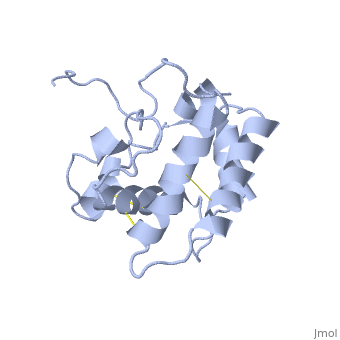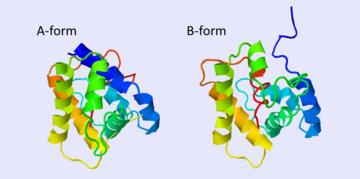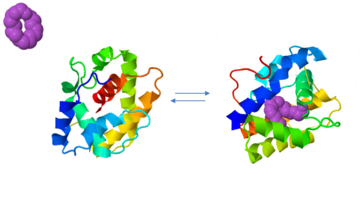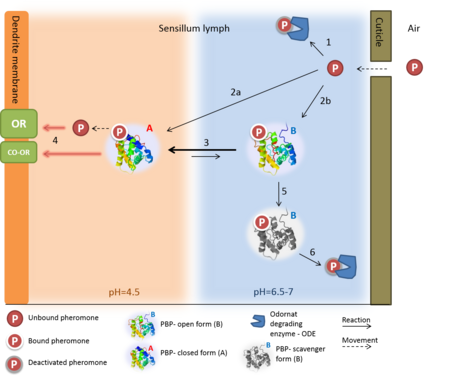Odorant binding protein
From Proteopedia
| Line 38: | Line 38: | ||
The protein natural ligand is the moth pheromone <scene name='68/683383/Bombykol_ligand_in_2p71/1'>Bombykol</scene>. However, it was demonstrated that other molecules can also bound to the protein cavity <ref>doi: 10.1016/j.str.2007.07.013</ref>. The interaction with the ligand is being made by 4 alpha helices 1, 4, 5 and 6 in the core of the protein, which form the binding cavity <ref>doi: 10.1016/S1074-5521(00)00078-8</ref>. | The protein natural ligand is the moth pheromone <scene name='68/683383/Bombykol_ligand_in_2p71/1'>Bombykol</scene>. However, it was demonstrated that other molecules can also bound to the protein cavity <ref>doi: 10.1016/j.str.2007.07.013</ref>. The interaction with the ligand is being made by 4 alpha helices 1, 4, 5 and 6 in the core of the protein, which form the binding cavity <ref>doi: 10.1016/S1074-5521(00)00078-8</ref>. | ||
Inside the binding cavity, <scene name='68/683383/Residues_interacting/1'>non-charged residues</scene> are interacting with the pheromone, mainly by van der waals bounds. Out of those residues, some are conserved across OBP of lepidopteran (<font color=#8DB600><b>in green</b></font>), and the rest are conserved in lepidopteran PBP only (<font color=#318CE7><b>in light blue</b></font>). | Inside the binding cavity, <scene name='68/683383/Residues_interacting/1'>non-charged residues</scene> are interacting with the pheromone, mainly by van der waals bounds. Out of those residues, some are conserved across OBP of lepidopteran (<font color=#8DB600><b>in green</b></font>), and the rest are conserved in lepidopteran PBP only (<font color=#318CE7><b>in light blue</b></font>). | ||
| - | In addition, the hydroxyl group of the pheromone bombykol forms a <scene name='68/683383/Ser56_interaction_with_oxg/2'>hydrogen bond with the | + | In addition, the hydroxyl group of the pheromone bombykol forms a <scene name='68/683383/Ser56_interaction_with_oxg/2'>hydrogen bond with the side chain of Ser56</scene>, Ser56 in red, oxygens are in purple (O–O distance of 2.8 Å). |
====Protein conformations==== | ====Protein conformations==== | ||
| Line 52: | Line 52: | ||
'''Conformation transition mechanism:''' | '''Conformation transition mechanism:''' | ||
The c-terminus of the protein bears mostly <scene name='68/683383/Hydrophobic_resid/1'>non-polar amino acids</scene>. Yet on the surface of the helix there are three exceptional amino acids: Asp-132, Glu-137, and Glu-141, which are conserved in moth PBP <ref>doi: 10.1016/j.bbrc.2005.07.176</ref>. Of these, residues <scene name='68/683383/Asp132/1'>Asp-132</scene> (and Glu-141, if present) triggers the formation of the alpha-helix upon protonation at low pH. This causes the transition from the <scene name='68/683383/B_form_with_ligand/1'>"A form"</scene>, to the <scene name='68/683383/A_form_with_ligand/1'>"B form"</scene> and the ejaculation of the ligand from the binding pocket, which is replaced by the formatted alpha helix<ref>doi: 10.1016/j.bbrc</ref>. | The c-terminus of the protein bears mostly <scene name='68/683383/Hydrophobic_resid/1'>non-polar amino acids</scene>. Yet on the surface of the helix there are three exceptional amino acids: Asp-132, Glu-137, and Glu-141, which are conserved in moth PBP <ref>doi: 10.1016/j.bbrc.2005.07.176</ref>. Of these, residues <scene name='68/683383/Asp132/1'>Asp-132</scene> (and Glu-141, if present) triggers the formation of the alpha-helix upon protonation at low pH. This causes the transition from the <scene name='68/683383/B_form_with_ligand/1'>"A form"</scene>, to the <scene name='68/683383/A_form_with_ligand/1'>"B form"</scene> and the ejaculation of the ligand from the binding pocket, which is replaced by the formatted alpha helix<ref>doi: 10.1016/j.bbrc</ref>. | ||
| - | Studies on other | + | Studies on other lepidopterans that show a similar pH dependent conformation suggests that this model is a general model moth PBP<ref name="Leal" />. Nonetheless, the enormous diversity among insects is not allowing us to assume this model is true for all insects' OBPs. |
[[Image:N model extended.png|thumb|upright=2.5|Figure 1. The events prior the neuron excitation, following the "N model" suggested by Kaissling (2009)<ref name="kaissling">DOI: 10.1007/s00359-009-0461-4</ref> The pheromone enters the sensillar lymph through a pore in cuticle. The pheromone can then be degraded by the ODE (1) -or- bind to the A and B protein forms (2a and 2b, respectively). When the complex arrives at the low pH near the membrane, the transition is in favor of the A-form, (3) in which the -c-terminus is forming an alpha helix inside the binding cavity, pushing out the pheromone. The activation of the complex of odorant receptor and coreceptor (OR:OR-CO), is induced by ether the complex of pheromone-PBP, or by the pheromone alone (5, two options). The B-form can also act as a scavenger, as it mediates the deactivation of the pheromone (6) and releases it to the ODE (6)]] | [[Image:N model extended.png|thumb|upright=2.5|Figure 1. The events prior the neuron excitation, following the "N model" suggested by Kaissling (2009)<ref name="kaissling">DOI: 10.1007/s00359-009-0461-4</ref> The pheromone enters the sensillar lymph through a pore in cuticle. The pheromone can then be degraded by the ODE (1) -or- bind to the A and B protein forms (2a and 2b, respectively). When the complex arrives at the low pH near the membrane, the transition is in favor of the A-form, (3) in which the -c-terminus is forming an alpha helix inside the binding cavity, pushing out the pheromone. The activation of the complex of odorant receptor and coreceptor (OR:OR-CO), is induced by ether the complex of pheromone-PBP, or by the pheromone alone (5, two options). The B-form can also act as a scavenger, as it mediates the deactivation of the pheromone (6) and releases it to the ODE (6)]] | ||
====Receptor activation==== | ====Receptor activation==== | ||
Revision as of 14:15, 28 January 2015
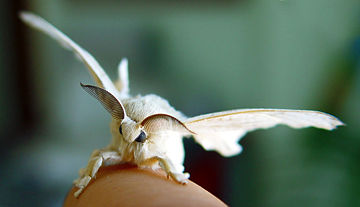
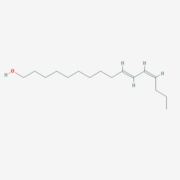
Contents |
Introduction
Odorant-binding protein (OBP) are soluble proteins which involve in the processes of odorant detection in the olfactory sensilla [1]. Though functionally same, vertebrates and insects OBP have different origin and structure. OBPs are important for insect olfaction. For instance, OBP76a (LUSH) in the fly Drosophila melanogaster is required for the detection of the pheromone vaccenyl acetate [2] and has been proven to adopt a conformation that activates the odorant receptor [3].
OBP in insects
OBP Function
Despite five decades of intensive research, the exact roles of OBP and the mechanism by which the odorant receptor (OR) is activated are still in dispute [4][5].
A few functions have been suggested for OBP:
1. Solubelizing the odorant molecule and its transportation in the sensillar lymph.
2. Protecting the odorant molecule from the odorant degrading enzymes, in the sensillar lymph.
3. Activating of the odorant receptor on the dendrite membrane, by the odorant-OBP complex.
4. Mediating the deactivation of the odorant molecule after the activation of the receptor.
5. An organic anion (the protein has 9 negative charges).
Of all, the first role of OBP as an odorant solubilizer and carrier is generally accepted.
In order to explain the structure and function of these fascinating proteins, this page will further focus on a particular OBP - the well investigated Bombyx mori pheromone binding protein: BmorPBP.
Bombyx mori BmorPBP (lets talk about sex..)
| |||||||||||
See also
- Odorant_binding_protein_3D_structures
- Chemical communication in arthropods
- Pheromone binding protein
References
Proteopedia Page Contributors and Editors (what is this?)
Nurit Eliash, Michal Harel, Joel L. Sussman, Alexander Berchansky, Jaime Prilusky
